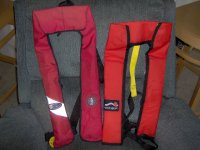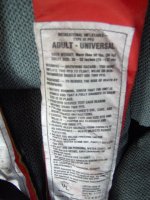Yellowstone
New member
- Joined
- Feb 7, 2006
- Messages
- 475
- Reaction score
- 0
- C Dory Year
- 1999
- C Dory Model
- 22 Classic
- Hull Identification Number
- DOR22849C999
- Vessel Name
- Farwest II
Glenn's comments about trying to get aboard using the swim step hits the nail on the head for the solo boater. He and Joe made an important point about fitness or lack thereof. Also, trying it out in a safe environment. We can disregard how any solo boater finds him or her self in the drink - leave that to one's imagination. How many of us actually would do what Glenn did, viz. go through a drill?
And even a drill may not prepare you for the real thing, but it did give Glenn the info he needed - to get some grab rails installed in strategic places and a fighting chance to get aboard.
Recall the difference between a drill and the real thing when I joined the Marine Corps. We trained on land to crawl down cargo nets to the ground. But when we landed on Inchon, it was down the nets into landing boats heaving and slaming into the troop ship. Had the pleasure of being ordered along with several others to go down the nets first to pull the bottoms away from the hull to help keep the troops from getting feet and legs mangled as they descended. Now when you are 18 and agile, it was an adventure of sorts, but when I got my feet safely passed the pinch zone, I decided to jump to the deck. Can still remember what the sting felt like in the ankles upon impact.
Glenn's candidness reminds us that few are physically capable of climbing up the swim step into the well. I know I couldn't without something to grab with both hands.
A quick assessment of the Far West II. suggests without a boarding ladder in place, crawling into the well would be most difficult. Now if your Dory has trim tabs, that is a place to put your feet. Weighted, they may drop a few inches, but they will support your weight. Next, where to grab on something. The edge of the well is difficult - but if you have the 1999 and previous models, the cleat is properly located as a grab point. Long arms will help. Also, the steering arm may give you something to grab.
Unfortunately, the new owners screwed up royally when they reconfigured the location of the rear cleats to run parallel with the hull. They are going to purgatory for that decision, not to mention the Mickey Mouse covers and small entrance into the lazarettes.
Excuse my rants. John
And even a drill may not prepare you for the real thing, but it did give Glenn the info he needed - to get some grab rails installed in strategic places and a fighting chance to get aboard.
Recall the difference between a drill and the real thing when I joined the Marine Corps. We trained on land to crawl down cargo nets to the ground. But when we landed on Inchon, it was down the nets into landing boats heaving and slaming into the troop ship. Had the pleasure of being ordered along with several others to go down the nets first to pull the bottoms away from the hull to help keep the troops from getting feet and legs mangled as they descended. Now when you are 18 and agile, it was an adventure of sorts, but when I got my feet safely passed the pinch zone, I decided to jump to the deck. Can still remember what the sting felt like in the ankles upon impact.
Glenn's candidness reminds us that few are physically capable of climbing up the swim step into the well. I know I couldn't without something to grab with both hands.
A quick assessment of the Far West II. suggests without a boarding ladder in place, crawling into the well would be most difficult. Now if your Dory has trim tabs, that is a place to put your feet. Weighted, they may drop a few inches, but they will support your weight. Next, where to grab on something. The edge of the well is difficult - but if you have the 1999 and previous models, the cleat is properly located as a grab point. Long arms will help. Also, the steering arm may give you something to grab.
Unfortunately, the new owners screwed up royally when they reconfigured the location of the rear cleats to run parallel with the hull. They are going to purgatory for that decision, not to mention the Mickey Mouse covers and small entrance into the lazarettes.
Excuse my rants. John


